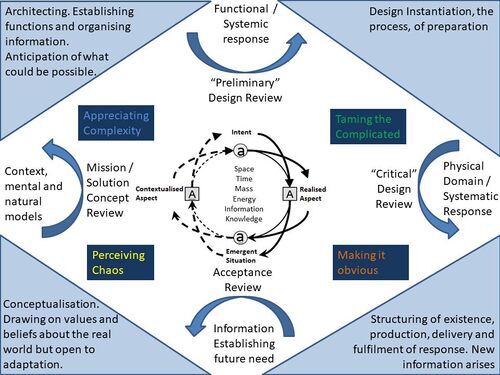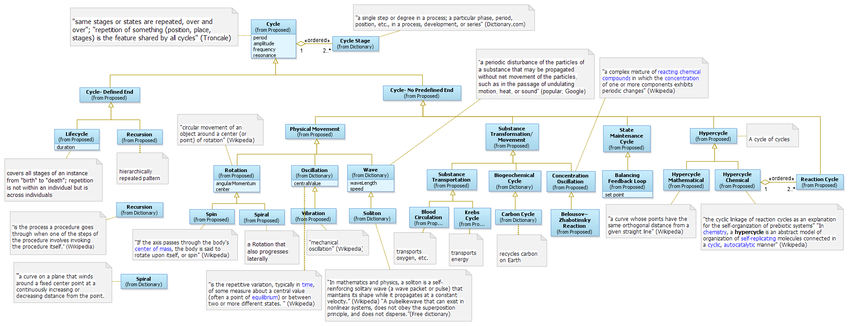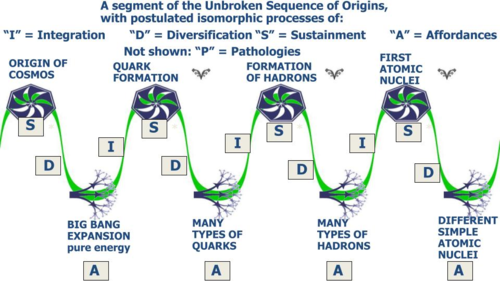Cycles and the Cyclic Nature of Systems
Acknowledgement
This article reflects established knowledge from systems science and systems engineering, organized and collated for the SEBoK. Drafting support was provided by OpenAI’s ChatGPT, with all content reviewed and finalized by the lead author, who retains full responsibility.
Framing and Definitions
This article is part of The Nature of Systems knowledge area (KA). Cycles and Phases are general system concepts studied across many sciences and recognized as fundamental patterns of Function. They complement the Form-focused concepts of identity, togetherness, behavior, and dynamics, by describing how systems unfold and repeat through time:
- Cycles refer to patterns of recurrence - sequences of events that return to their starting conditions or repeat in recognizable rhythm.
- Phases refer to patterns of progression - the sequential stages through which systems emerge, develop, mature, decline, or transform
Crucially, each phase is characterized by distinctive underlying behaviors and functions, not simply by its position in sequence. For example:
- Early phases emphasize exploration and innovation.
- Growth phases emphasize structuring and scaling.
- Maturity phases emphasize conservation and optimization.
- Decline and release phases emphasize breakdown and transformation, opening the way for renewal.
Several definitions illustrate the breadth of the cycle concept:
- “A series of events that are regularly repeated in the same order; or move in or follow a regularly repeated sequence of events.” — Oxford English Dictionary
- “Cycles define and make things. Equally things contain cycles.” — Volk (1995)
- “A temporal pattern.” — Mobus and Kalton (2015)
- “The longer and more regular the series is repeated, the more predictable it becomes, until it cannot reasonably be considered a coincidence.” — Foundation for the Study of Cycles
- “Circularity is the essence of the early notion of feedback (circular causality). The notion of circularity is found in recursive computation (the use of DO loops, for example).” — Krippendorff (1984)
Phases are equally universal. Troncale (1978) observed that “all living (even non-living) entities of the same class exhibit the same phases in their life cycle – birth, maturation, death, dissolution.” Such phase patterns are instantiated in natural systems, ecological succession, social processes, and engineered lifecycles.
Position in the Fit–Form–Function Framework:
- Form concepts (identity, togetherness, behavior, dynamics) describe what a system is and how it acts internally.
- Function concepts (cycles, phases, purpose, capabilities) describe what a system does through time and the recurring temporal structures it expresses.
- Cycles and Phases are the first major categorization of Function, forming a bridge between the internal dynamics of systems and the observable patterns of activity that structure their engagement with context.
Introduction: Ubiquity of Cycles and Phases
Movement and evolution are fundamental in the dynamics of nature, and cycles and phases are evident across nearly every domain of inquiry. Because of their generality, they are key concepts for systemists: they provide a common language, inspire systemic thinking, and offer practical means for engaging with systems.
- Cycles appear as repeated patterns or rhythms of activity, from planetary orbits and ecological renewal to decision-making routines and enterprise management. They provide continuity and predictability by connecting events across time.
- Phases appear as ordered stages of progression, such as birth, growth, maturity, decline, and renewal in both living and non-living systems. Each phase expresses distinctive behaviors and functions, shaping the way systems interact with their environment and with one another.
Examples across the sciences illustrate their ubiquity:
- Ecology: adaptive cycles of exploitation, conservation, release, and reorganization (Allen & Hoekstra 1992; Gunderson 2013).
- Social science: planning and intervention cycles, often structured as sequential phases of inquiry and action (Sankaran et al. 2015).
- Business and learning: reinforcing cycles of cause and effect, as in Senge’s insight that “today’s problems come from yesterday’s solutions” (Senge 2006).
- Cybernetics: circular causality and feedback cycles that underpin control and regulation (Krippendorff 1984).
- Physics: coherence and decoherence cycles in quantum mechanics (Hsiang & Ford 2009).
- Systems biology: modeling and interpretation cycles in living systems (Rosen 1991a, 1991b).
Cycles and phases are equally evident in engineered practice:
- Project and system lifecycles,
- Enterprise planning horizons,
- Iterative and spiral development methods,
- The recursive structure of the scientific method itself.
Together, these examples demonstrate that cycles and phases are among the most pervasive and useful concepts in systems science. They provide one of the most powerful entry points for recognizing Function in systems, linking natural phenomena, social processes, and engineered practice.
Cycles and Phases in Frameworks
Cycles and phases are embedded in frameworks that guide inquiry, management, and engineering practice. These illustrate how recurrence and progression structure systemic understanding and action.
- Cynefin Framework – A situational sense-making model highlighting transitions between ordered, complex, and chaotic domains. These transitions represent phases of context, while iterative exploration and re-categorization illustrate cycles of learning and adaptation.
- Panarchy – A theory of adaptive cycles in ecosystems and social–ecological systems (Gunderson & Holling 2002). It describes phases of exploitation, conservation, release, and reorganization, while nested cycles link local dynamics with broader cross-scale interactions.
- OODA Loop – The Observe–Orient–Decide–Act decision framework developed in military contexts. It presents a sequential set of phases that, when repeated rapidly, form a cycle enabling agility under pressure.
- Spiral Model of Software Development – An iterative engineering lifecycle combining sequential phases (requirements, design, implementation, testing) with recurring cycles of refinement and risk assessment.
- Problem/Solution Systems and Action Research – Frameworks such as Plan–Act–Observe–Reflect represent explicit phases of inquiry, embedded in recursive cycles of practice and reflection that build cumulative learning.
- Senge’s First Law – “Today’s problems come from yesterday’s solutions” (Senge 2006). This highlights the recursive nature of interventions, in which each solution cycle produces conditions that shape subsequent phases of systemic response.
- Relational Holon – Building on Rosen and extended by Kineman, the holon models the reciprocity of system and context. It frames phases of origin, realization, interaction, and transformation as aspects of a recurring cycle that repeats across scales of organization.
- Life Cycle Management – The management of software, products, services, and enterprises is structured by sequential phases of concept, development, operation, and retirement, interwoven with renewal cycles such as upgrades and iterations.
- Scientific Method – A canonical example of sequential phases (hypothesis, experiment, analysis, conclusion) that are repeated across cycles of inquiry to build cumulative knowledge.
- Systems Engineering Life Cycle – The discipline of systems engineering itself is organized around project phases (concept, development, operation, retirement) linked by iterative cycles of feedback, review, and refinement.
Together, these frameworks demonstrate that cycles and phases are not abstractions but operational tools, shaping how problems are framed, solutions are developed, and systems are managed across contexts. They also reveal a pattern: phases provide structure for progression, while cycles enable iteration and renewal, a distinction that will be integrated in the models and archetypes described in the following sections.
Integrated Models of Cycles and Phases
While individual frameworks illustrate specific forms of recurrence and progression, some models demonstrate how cycles and phases can be aligned across theory and practice. These integrations show coherence between systemic concepts and engineering application.
- Systems Engineering Lifecycle and Relational Holon – The phases of the systems engineering lifecycle (concept, development, operation, retirement) can be mapped onto the relational holon’s phases of origin, realization, interaction, and transformation. This highlights how theoretical models of system–context reciprocity can inform practical engineering lifecycles.
- Cynefin and Lifecycle Phases – The Cynefin framework complements lifecycle thinking by showing how sense-making transitions (ordered ↔ complex ↔ chaotic) align with, or disrupt, engineering phases. This helps practitioners recognize when iterative cycles are required rather than linear progression.

Further integrative perspectives have been contributed through the International Society for the Systems Sciences (ISSS). These include Len Troncale’s Unbroken Sequence of Origins, which postulates recurrent patterns of system emergence, and Tyler Volk’s metapatterns, which reveal binding, breaking, and renewal cycles across domains. Video contributions by Troncale, Volk, and Smith further illustrate how cycles and phases connect scientific insight with systems practice (ISSS Cycle Contributions).
Recurrent Isomorphies
Beyond applied frameworks, cycles and phases can be understood as isomorphic processes, recurring systemic patterns observed across multiple domains of science. These provide a deeper theoretical grounding for systems science and practice.
Len Troncale (1978) systematically documented recurrent patterns of cycling, showing evidence of over 250 natural and social phenomena across seven major scientific disciplines. This work forms part of Systems Process Theory, which seeks to identify the universal processes underpinning system behavior and to establish a unifying empirical foundation for systems science.
This figure illustrates a waveform pattern of recurrent processes and phases spanning the Unbroken Sequence of Origins. Troncale observed that “all living (and even non-living) entities of the same class exhibit the same phases (form) in their life cycle – birth, maturation, death, dissolution.” Subsequent collaborative work extended this pattern to include additional processes such as affordances (opening new relational possibilities) and sustainment (maintenance of systemic coherence).
These recurrent isomorphies show that cycles and phases are not arbitrary constructs but reflect enduring structures of reality. By recognizing and classifying these universal processes, systemists and engineers can design, maintain, and apply lifecycle processes with greater fidelity. In this sense, isomorphies provide a scientific foundation for connecting systemic Function to practical systems engineering.
Archetypes of Cycles and Phases
Cycles and phases can be abstracted into archetypes — recurrent patterns that generalize across domains of science, society, and engineering. Archetypes make the underlying logic of cycles and phases tangible, and provide a bridge between systemic theory and practical application.
Cycle Archetypes
Cycle archetypes emphasize recurrence and rhythm — the repeating patterns that sustain systems over time.
- Feedback Loops – reinforcing or balancing interactions that generate recurrence.
- Found in ecological predator–prey oscillations, organizational decision loops, and engineering control systems.
- Iterative Cycles – repetition with refinement, building cumulative improvements.
- Evident in scientific experimentation, agile sprints, and spiral development models.
- Nested Cycles – cycles within cycles operating at multiple scales.
- Examples include ecological panarchy (local ↔ global) or enterprise planning cycles embedded within strategic horizons.
- Coupled Cycles – interacting cycles that synchronize or conflict with one another.
- Examples include economic and political cycles, or product refresh cycles interacting with regulatory approval cycles.

Cycles manifest across domains as feedback, iteration, nesting, and coupling. Each archetype captures a distinctive way in which recurrence is structured and maintained. These archetypes provide analogies for engineering practice, supporting system control, iterative design, multi-level management, and coordination across interdependent cycles.
Phase Archetypes
Phase archetypes emphasize progression and transformation, the ordered stages through which systems evolve. Each phase expresses distinctive behaviors and functions:
- Life Phases – exploration (birth), structuring (growth), optimization (maturity), release (decline), renewal (reorganization).
- Found in organisms, stars, and engineered product lifecycles.
- Adaptive Cycles – exploitation → conservation → release → reorganization.
- Widely used to describe ecosystem resilience and enterprise renewal.
- Development Phases – design, build, operate, sustain.
- Common to engineered projects, infrastructure systems, and the SE V-model.
- Decision Phases – observe, orient, decide, act.
- Characterize situational decision-making and agile team practices.
Recognizing these archetypes reinforces that phases are not arbitrary labels but distinct systemic states with characteristic behaviors and functions.
Integrative Archetypes
Some systemic models combine cycles and phases, illustrating how recurrence and progression interrelate:
- Troncale’s isomorphies – recurrent processes that manifest as ordered sequences of phases across the Unbroken Sequence of Origins.
- Volk’s metapatterns – binding, breaking, and renewal cycles repeated across levels of emergence.
- Relational Holon – reciprocal phases of origin, realization, interaction, and transformation, embedded in cyclical relation between system and context.
- Systems Engineering Lifecycles – sequential phases (concept, development, operation, retirement) structured by iterative cycles of review and renewal.
Together, these archetypes demonstrate that:
- Cycles structure recurrence.
- Phases structure progression.
- Integrative archetypes connect the two, showing how systemic Function arises from the interplay of recurring rhythms and ordered transformations.
Implications for Systems Engineering
Cycles and phases underpin many methods and lifecycles in systems engineering. Recognizing their archetypes enables practitioners to align practice with systemic Function, anticipate transitions, and design for resilience.
- Concept Definition
- Phase archetype (life phases – birth): emphasizes exploration, creativity, and innovation.
- Cycle archetype (feedback loops): stakeholder engagement and iterative feedback ensure robustness of early concepts.
- Design and Development
- Phase archetype (growth): emphasizes structuring, scaling, and alignment of resources.
- Cycle archetype (iterative cycles): spiral development and agile sprints support progressive refinement.
- Integrative archetype (relational holon): highlights the reciprocity of system–context relations in design choices.
- Integration, Verification, and Validation (V&V)
- Phase archetype (maturity): emphasizes assurance, stability, and optimization of function.
- Cycle archetype (feedback loops): V-model structures link requirements definition to validation, closing the loop.
- Phase archetype (decision phases): V&V reviews can be structured as OODA loops, supporting adaptive decision-making.
- Operation and Sustainment
- Phase archetype (maturity/conservation): emphasizes reliability, optimization, and efficiency.
- Cycle archetype (renewal cycles): upgrades, maintenance, and feedback-informed adjustments sustain long-term performance.
- Retirement and Renewal
- Phase archetype (decline/release and reorganization): emphasizes transformation, resource recovery, and closure.
- Cycle archetype (nested cycles): feedback from decommissioning informs the birth of next-generation systems.
- Enterprise and System of Systems (SoS)
- Cycle archetypes (nested and coupled cycles): illustrate how enterprise planning horizons, regulatory cycles, and product lifecycles must be harmonized.
- Integrative archetypes (panarchy): reveal how cross-scale cycle alignment supports systemic resilience.
- Risk and Resilience
- Phase archetype (adaptive cycle transitions): tipping points occur at shifts from conservation to release, highlighting fragility.
- Cycle archetype (critical feedback loops): reinforcing loops can escalate into cascading failures, while balancing loops maintain resilience.
- Sustainability and Long-Term Viability
- Integrative archetypes (ecological and societal cycles): engineered systems exist within planetary boundaries and biogeochemical cycles.
- Phase archetypes (life and adaptive cycles): awareness of systemic phases supports alignment with sustainability goals and long-term resilience.
Summary:
- Phases embody distinctive systemic behaviors and functions (exploration, structuring, optimization, release, renewal).
- Cycles provide the recurrence and feedback rhythms that connect phases across time and scale.
- Integrative archetypes demonstrate how recurrence and progression interrelate, ensuring engineering practice remains coherent with both internal system dynamics and external contexts.
References
Works Cited
Allen, T.F.H. & Hoekstra, T.W. (1992) Toward a Unified Ecology. Columbia University Press.
Bell, S. (2012) DPSIR = A Problem Structuring Method? An exploration from the “Imagine” approach. European Journal of Operational Research, 222, 350–360.
Gunderson, L.H. (2013) Panarchy Synopsis: Understanding Transformations in Human and Natural Systems. Island Press.
Hsiang, J.-T. & Ford, L.H. (2009) Decoherence and Recoherence in Model Quantum Systems. International Journal of Modern Physics A, 24, 1705–1712.
Krippendorff, K. (1984). An Epistemological Foundation for Communication. Journal of Communication 34(3), 21-36.
Oxford English Dictionary. 2020. s.v. "Cycle".
Rosen, R. (1991a) Beyond dynamical systems. Journal of Social and Biological Structures, 14, 217–220.
Rosen, R. (1991b) Life Itself: A Comprehensive Inquiry into the Nature, Origin, and Fabrication of Life. Columbia University Press.
Sankaran, S., Dick, B., Passfield, R. & Swepson, P. (2015) Effective Change Management Using Action Learning and Action Research. n/a, Lismore, NSW, Australia.
Senge, P.M. (2006) The Fifth Discipline: The Art & Practice of The Learning Organization, Revised&Updated. Doubleday, New York.
Wikipedia.org. 2020. "List of Cycles". https://en.wikipedia.org/wiki/List_of_cycles
Primary References
Forsberg, K., H. Mooz, H. Cotterman. 2005. Visualizing Project Management, 3rd ed. New York, NY, USA: J. Wiley & Sons.
Kineman, J.J. 2017. Chapter 2, Systems Research Framework, A Guide to Systems Research. Springer.
Mobus, G.E and M.C. Kalton. 2015. Principles of System Science. Springer.
Troncale, L.R. 1978. Nature’s Enduring Patterns. California State Polytechnic University.
Volk, T. 1996. Metapatterns. Columbia University Press.
Additional References
Daniel-Allegro B, Smith G.R. (2016). Exploring the branches of the system landscape, Les editions Allegro Brigitte D. ISBN 978-2-9538007-1-5.
Kineman, J.J. (2011) Relational Science: A synthesis. Axiomathes, 21, 393–437.
Mobus, G.E. 2022. System Science: Theory, Analysis, Modeling and Design. New York, NY, USA: Springer.
The Foundation for the Study of Cycles. 2020. "Cycle" https://cycles.org/.
Videos
Video presentations on the unbroken sequence of origins by Len Troncale and on Cycles by Tyler Volk and Gary Smith are available ISSS Cycle Contributions. https://www.isss.org/sebok-contribution/
